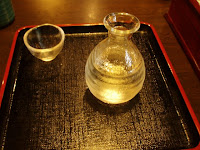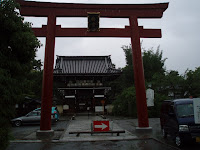Matsuo Shrine is located in Saikyo Ward, Kyoto City, and Umenomiya Shrine is in Ukyo Ward in the city. Although they are located in different wards, I learned from the map that the two shrines were not very far from each other, and I could walk from one to the other. Both shrines are accessible on foot from Matsuo Station on Hankyu Arashiyama line.
I took Hankyu Kyoto line and then Hankyu Arashiyama line to get to Matsuo Station. When I came out from the station, it was raining unfortunately, worse still, pouring down. After hesitating a while, I daringly stepped in the downpour with my seemingly undependable collapsible umbrella unfolded. Just all the same, Matsuo Shrine was very close to the station, and I could actually see a torii gate of the shrine when coming out from the station. Apparently due to this nasty weather, only a few people were visiting the shrine. But, this was a shrine of a nice atmosphere.


There are several gardens on the premises of this shrine. I could see these gardens including Kyokusui no Niwa, Joko no Niwa, and Hourai no Niwa (admission fee: 500 yen).
At first, I thought these were old gardens, but it was not true. The construction of these gardens was completed in 1975.
In the Kyokusui no Niwa garden, a meandering stream was flowing modestly. When I entered the garden from the upstream side, I saw big stones were placed on the slope on the left. The stones stood high and they pointed the sky as if they were rocks in deep mountains. The stream running around the foot of the slope looked like a mountain creek. The stream viewed from the downstream side looked as if it were a long and grand river that ran over hundreds of kilometers. It is amazing that this small-sized garden represents the sublimeness of the great nature.
The Joko no Niwa garden was placed in the stillness and tranquility of deep mountains. Arranged big stones are said to represent the enshrined gods of this shrine and their subordinate gods.
The Horai no Niwa garden is a walk-around type garden, where you can enjoy walking around in the garden to admire various views of the garden from different spots. A lot of big stones were placed also in this garden. These big stones were beautifully arranged in the center pond, exhibiting some sense of rhythm and tension. If it had not been raining that hard, I would have stayed longer and enjoyed walking around in the garden.



Matsuo Shrine is a shrine of sake-making god, and it seemed very natural that they were selling sake in the restaurant on the premises.

The rain was persistent and did not seem to stop very soon when I left Matsuo Shrine. Walking in this rain to Umenomiya Shrine did not seem to be a pleasant experience. After somehow hesitating, I finally decided to head for Umenomiya Shrine because this was a rare chance to visit the shrine. Before I reached the shrine, my shoes were completely soaked through by the rain. After about a ten-minute walk, I came to the place of a direction signboard of Umenomiya Shrine Front Approach.

Another god of sake-making is enshrined in this shrine.


2 comments:
Dear Ichiro,
Thank you for the post of Matsuo Shrine. I stopped there on my visit to Kyoto last month - I too wanted to offer thanks to the sake gods!
Valerie
Dear Valerie,
Thank you for the comment.
For sake lovers, there are many places to visit in Kyoto, aren't they?
I also visited Fushimi in Kyoto, a place of many sake breweries. I think I must write something about my visit to Fushimi.
Ichiro
Post a Comment